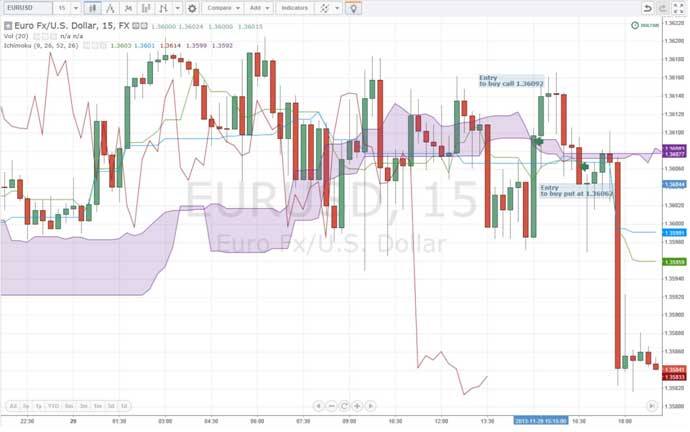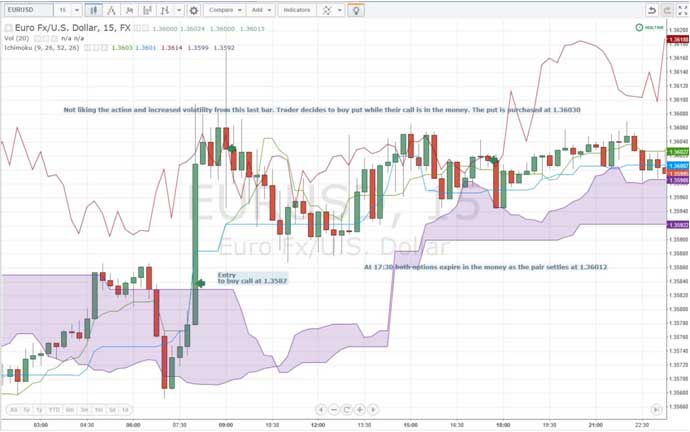The Art of Hedging Binary Options – The Right Way!
All in all, trading binary options are not as risky as say trading FX, commodities or stocks. The reality is that you are in control of the risk. How so? For the most part, you can only lose what you invest. For example, if you place a trade for $100, betting that the EUR/USD will be higher than 1.3587 and you’re wrong, the max that you could lose is $100. It doesn’t matter how wrong you end up being, the risk is always limited to whatever you put in. With that said, one could argue that a binary options trade has an embedded stop or hedge already in place.
So what are the benefits of hedging binary option trades? The answer is simple. To reduce risk, minimize losses or protect profits. But don’t get confused. Hedging is a risk management technique, in binary options trading, it’s not used to generate alpha.
Now let’s put this into perspective for a moment.
Hedging a Potential Loss
 Let’s assume the trader is making a bet on the EUR/USD. The trader buys a call thinking that the pair will be above 1.36092, on the chart you’ll see that it is about to break above the Ichimoku cloud (15 min chart). The trader buys the call for $100 with a 75% payout if they are right. After an initial pop, the pair starts to breakdown. The call is now out of the money, not only that, but it’s now broken below the cloud. As a hedge, the trader buys a put on the EUR/USD at 1.36062. Now, there are a couple of ways to potentially play this. However, there is a chance for both the call and put to lose money if the pair is higher than 1.36062 and lower than 1.36092. With that said, the trader decides to spend $100 on the put option.
Let’s assume the trader is making a bet on the EUR/USD. The trader buys a call thinking that the pair will be above 1.36092, on the chart you’ll see that it is about to break above the Ichimoku cloud (15 min chart). The trader buys the call for $100 with a 75% payout if they are right. After an initial pop, the pair starts to breakdown. The call is now out of the money, not only that, but it’s now broken below the cloud. As a hedge, the trader buys a put on the EUR/USD at 1.36062. Now, there are a couple of ways to potentially play this. However, there is a chance for both the call and put to lose money if the pair is higher than 1.36062 and lower than 1.36092. With that said, the trader decides to spend $100 on the put option.
The max risk is now $200. If the call goes in the money, the trade will make $75 – $100 they lose on the put. If the put goes in the money the trader will make $75 -$100 they lose from the call. As you can see, the best case scenario is a net loss of $25. Assuming expiration was at 18:00, the call was a loser and the put was a winner. An end result of a loss of $25. However, if the trader just stuck with the long call, they would have lost $100.
Hedging to Protect a Winner
 Let’s assume the trader is making a bet on the EUR/USD. The trader buys a call thinking the pair will be above 1.3587, on the chart you’ll see that it has broken above the Ichimoku cloud (15 min chart). The trader buys the call for $100 with a 75% payout if they are right. As predicted, the EUR/USD surges higher. A little less than an hour passes and the trader notices what appears to be a Doji candlestick formation. The trader fears that this could be a reversal. With that said, they decide to buy a put option at 1.36030. Keep in mind, they are in the money on the call options. In this case, the initial trade is still working for them. Instead of buying the put for $100, they decide to spend $50.
Let’s assume the trader is making a bet on the EUR/USD. The trader buys a call thinking the pair will be above 1.3587, on the chart you’ll see that it has broken above the Ichimoku cloud (15 min chart). The trader buys the call for $100 with a 75% payout if they are right. As predicted, the EUR/USD surges higher. A little less than an hour passes and the trader notices what appears to be a Doji candlestick formation. The trader fears that this could be a reversal. With that said, they decide to buy a put option at 1.36030. Keep in mind, they are in the money on the call options. In this case, the initial trade is still working for them. Instead of buying the put for $100, they decide to spend $50.
The max risk on the trade is a loss of $62.50. If the EUR/USD is below 1.3587, they will lose $100 on the call and make $37.50 on the put. If the EUR/USD is above 1.3587 and above 1.36030 they will make $25 on the trade. But get this, if the EUR/USD is above 1.3587 and below 1.36030, they will win on both sides of the trade, for a total profit of $112.50. Assuming expiration was at 17:30, the EUR/USD settled at 1.3012, making both trades winners. If the trader just stuck with the initial call, they would have made $75. However, by adding the put they were able to generate additional income.
In conclusion, hedging is a useful technique to try to smooth out losses. Not only that, but it can be used to protect winning trades. Remember, you put on trades because you feel you’ve got an edge. However, during periods of uncertainty or high volatility, it makes sense to look for ways to hedge a position. A question good traders often ask is: How can I make my position stronger? By keeping hedging in the back of your mind, you might be able to reduce the size of your losses and protect your winners.
